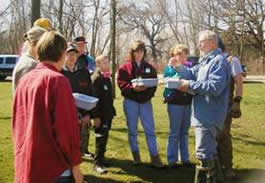Steps for Choosing Effective Outreach Techniques
1. Describe the environmental concern or opportunity.
2. Identify preliminary target audience(s).
3. Determine specific actions citizens need to take to accomplish your management goal.
4. Collect audience information relevant to the environmental practices and specific behaviors.
5. Assess potential for adoption of single behaviors and the environmental practice.
6. Select single behaviors for intervention focus.
7. Select intervention technique(s).
Step 3. Determine specific actions residents need to take to accomplish your management goal
Confirm specific environmental practice
In Steps 1 and 2 you’ve identified the environmental concern or opportunity you want to address and the target audience. The next step is to describe the specific practice that a specific audience can implement to address the environmental problem. Once you’ve confirmed these specific action components, you will have the information you need to develop an effective outreach plan.
An outreach plan that address specific gaps in an individual’s behavior, in place of providing general advice about a situation, is more likely to result in changed behavior and measurable impacts.
Refer to the Track Your Progress Worksheet, page 2, for more details about this process.
 Example of specific actions
Example of specific actions
As an example, here is an analysis of single behaviors involved in managing household waste in an environmentally sound manner.
GOAL: Identify single, ideal behaviors for managing household waste by an individual.
Behaviors might include:
- Separate recyclable containers, paper, hazardous materials, and organic materials from other trash
- Store each type of material in separate containers
- Put out appropriate materials on the correct pick-up day
- Compost organic garbage
- Take hazardous materials to the appropriate collection site
Follow these steps to analyze behavior requirements:
Here is a process you could follow to analyze the behaviors involved in a specific environmental practice. As a result you will determine the single steps that an individual would take.
- Describe or name the preferred environmental practice. What do you want residents to do?
- Further describe the preferred practice in terms of a series of several related behaviors which, taken together, could have an impact on the environmental problem.
- See below for further recommendations for how to identify, confirm, and spell out the environmental practice.
- Examine each single behavior to assure that it is required to implement the environmental practice and that it is a single, observable action.
- An ideal behavior is a single, observable action that experts consider people need to perform in order to reduce or help resolve a specific environmental problem.
- Identify target audiences who can perform these specific steps.
- Primary audiences are people who perform the behavior.
- Secondary audiences are people who influence the primary audience.
- Express ideal behaviors as:
- What the primary or secondary audience should do, not what should be done for them
- Specific behaviors (begin with an action verb)
- Single, observable events
- One behavior per statement
Identify and confirm the appropriate environmental practice and component steps.
To determine the most appropriate environmental practice and its component steps, you will need to take some time to examine current practices. The most effective strategy involves engaging the target audience, as well as content experts, in an observation and analysis process. Once you’ve gathered your advisory group, follow these suggested steps:
1. Compare “doers” and “non-doers.” What specific factors make one adopt a practice and the other not?
2. Identify skills and performance deficits. Do people refrain from a practice because they don’t know how to do it or because of other factors, such as access to appropriate technology or lack of awareness of positive consequences?
3. Address skills deficit. Develop strategies which provide skill information or teach necessary skills.
4. Address performance deficit. Identify strategies that reduce barriers and increase positive consequences.
5. Conduct quantitative research. Pilot test an outreach or education program that addresses skill and performance deficits with a sample of the target audience. Determine applicability of the study sample to the larger audience. Fine tune recommendations.
6. Conduct behavior trials. Test whether the refined behavior actually results in the desired environmental impact. If not, re-analyze behaviors required to lead to the desired result.
Source:
Adapted from Starting With Behavior, Elizabeth Mills Booth, 1996 and Promoting a Sustainable Future, Doug McKenzie-Mohr, 1995.



